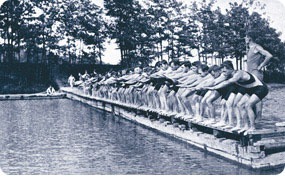
YMCA swimming, 1910-1914.
Local History
- In 1908 the Y completed a facility on the corner of Fifth Street and Shelby Street. The facility is a four story building which included a full basement, two bowling alleys, gymnasium swimming pool, game room large recreation room, auditorium, and thirty-two dorm rooms.
- In 1925 Camp Cherokee was built as a resident camp.
- In 1942 Camp Cherokee was closed due to the work of the TVA.
World History
- In 1903 the YMCA created an “industrial” department to work with railroad workers, miners and lumbermen, and to assist immigrants. Today, YMCAs respond to changing demographics through refugee services, welcome centers, adult education classes, and more.
- In answer to a YMCA campaign “to teach every man and boy in North America” to swim, George Corsan arrived at the Detroit YMCA in 1909 to teach swimming using radical new methods: group swimming lessons and lessons on land as a confidence builder. In Newark, New Jersey alone, he taught 800 boys to swim in just four weeks.
- In 1910 25 black YMCAs were built in 23 cities as a result of a challenge grant program announced by Sears Roebuck founder Julius Rosenwald. The Y’s included clean, safe dorm rooms and eating facilities, which were a boon to black travelers, especially servicemen, in a segregated and discriminatory era.
- Swimming classes expanded throughout the century to include families and people with disabilities. In addition to helping youth feel safe around water, swim activities developed kids’ problem solving abilities and bolstered their self-esteem.
- Throughout World War I, the YMCA provided morale and welfare services for the military. By war’s end, the YMCA, through the United War Work Council, had operated 1,500 canteens in the United States and France: set up 4,000 YMCA huts for recreation and religious services; and raised more than $235 million-equivalent to $4.3 billion today-for relief work.
- In 1926 YMCAs made a commitment to families when the parent-child program Y-Indian Guides began in the St. Louis YMCA. Started by Harold J. Keltner and Joe Friday, a member of the Ojibway tribe, the program was based on the Native American family model and sought to foster the companionship of father and son. The program later expanded to include father-daughter (Y-Indian Princes), mother-son, mother-daughter (Y-Indian Maiden) and parent-preschooler components.
- Sponsored by the New York State YMCA, the YMCA Youth Y Government program began in Albany in 1936. The program encourages high school students to understand the processes of government and to prepare to participate in it.
- During World War II the YMCA, along with five other national voluntary organizations, founded the United Service Organizations for National Defense, today known as the USO.
- Also during World War II, YMCA staff worked secretly in U.S. internment camps holding 110,000 Japanese Americans, organizing clubs and activities for the children.
- In 1950 YMCA volunteer Joe Sobek invented racquetball in Greenwich, Connecticut, as an alternative to squash and handball. Like previous YMCA inventors, Sobek was not paid for his invention; he bestowed it as a gift to all who play the game today.
- From 1956 to 1966 the YMCA Building for Brotherhood campaign raised more than $5.5 million to strengthen the infrastructure of many YMCA national organizations and established a YMCA presence in several countries around the world.
Founding | 1800 – 1860s | 1870 – 1890s | 1900 – 1950s | 1960 – 1990s | 2000 – present

